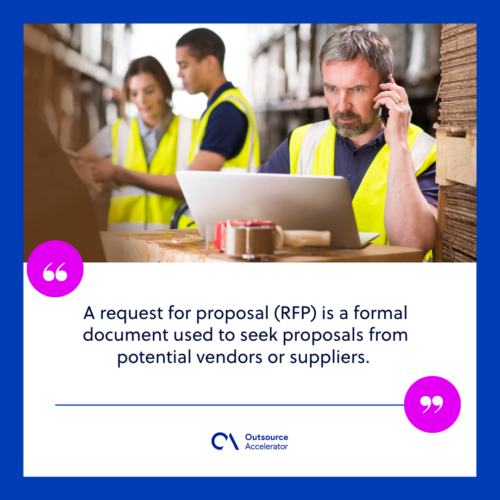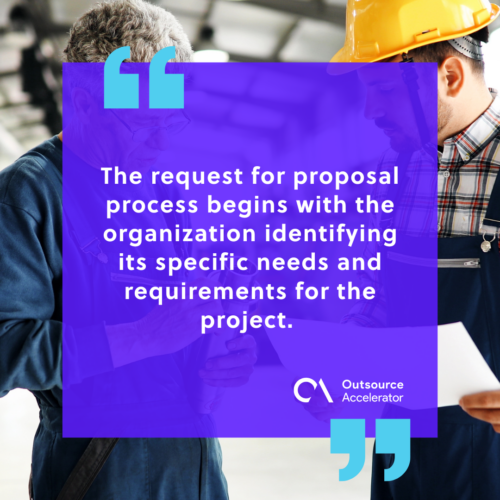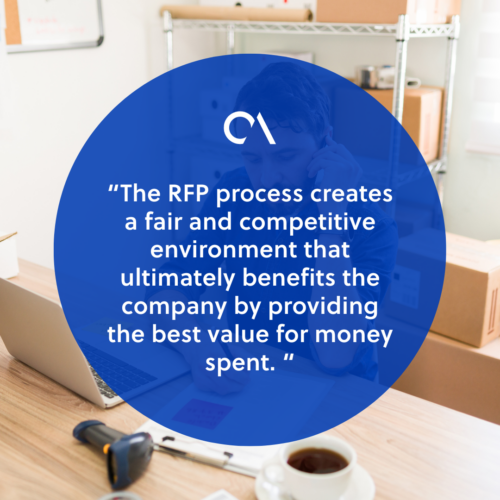Request for proposal (RFP) essentials: A blueprint for success

Organizations often find themselves in need of external expertise or services to achieve their goals efficiently. The process of finding ideal partners can be challenging, but it’s key to attaining successful outcomes.
This is where a well-crafted request for proposal (RFP) comes into play.
This meticulously structured mechanism allows companies to express their specific needs and expectations. At the same time, it provides potential partners with a clear framework for presenting their capabilities and solutions.
Companies must learn to master the art of crafting and responding to RFPs to create mutually beneficial alliances.
This article aims to give you the fundamentals of a request for proposal, its process, significance, and some tips for writing effective documents.
What is a request for proposal (RFP)?
A request for proposal (RFP) is a formal document used to seek proposals from potential vendors or suppliers. These documents may be for specific projects, products, or services.
Essentially, an RFP serves as an invitation for qualified businesses to submit detailed proposals outlining their capabilities, solutions, and pricing.
The request for proposal process is widely employed in various industries, facilitating fair competition and enabling organizations to make insightful decisions.

Key components of a request for proposal
A well-constructed request for proposal typically includes several key components.
These are essential for providing potential vendors with the necessary information to understand the company’s requirements and submit complementary proposals.
Some of the vital components include:
- Introduction – This section provides an overview of the organization, the purpose of the RFP, and any background information relevant to the project or service being procured.
- Scope of work – This outlines specific tasks, deliverables, and objectives of the project. It should specify the project’s goals and what the organization expects from potential vendors.
- Statement of need – It defines specific needs, such as technical specifications, standards, and any qualifications or certifications that vendors must meet to be eligible.
- Timeline – This RFP component details the proposed timeline for the project, including important milestones, deadlines, and any notable events or dependencies.
- Evaluation criteria – Organizations must include a set of criteria against which they will evaluate the proposals. Factors can include vendor experience, proposed solutions, pricing, and responsiveness.
- Proposal format – The RFP should provide instructions on how vendors must structure and format their proposals.
- Terms and conditions – This outlines the terms and conditions that apply to the RFP process, including any legal or contractual considerations, payment terms, and intellectual property rights.
The request for proposal (RFP) process
The request for proposal process is a structured and methodical approach to solicit and evaluate vendor proposals.
While the specific steps may vary depending on the organization and project, here is a general overview:
Identification of project needs
The request for proposal process begins with the organization identifying its specific needs and requirements for the project.
This involves understanding the objectives, scope, desired outcomes, and constraints to provide a foundation for the RFP.

RFP document preparation
The company then develops a comprehensive RFP document containing all the key components.
Those writing the document must conduct an internal review to ensure alignment with organizational goals, clarity, and completeness. They must also obtain necessary approvals from stakeholders before releasing it.
Publishing and distribution
After the request for proposal is prepared, it is published and distributed to potential vendors.
This can be done through various means, such as:
- Posting it on company websites
- Sending it directly to vendors
- Advertising it on procurement portals
Companies must clearly communicate the deadline for proposal submission and provide a mechanism for clarifications.
Vendor clarifications
Vendors may seek clarifications on certain aspects of the RFP. The organization responds to these queries in a timely manner to ensure that all vendors have the same understanding of the requirements.
Proposal submissions
Vendors prepare and submit their proposals based on the guidelines indicated in the RFP. These documents contain details about their capabilities, experience, and solutions.
Proposal evaluation
The organization evaluates the proposals based on predetermined evaluation criteria. It may assign scores or rankings to various aspects of the proposal.
Shortlisting and selection
After evaluating the proposals, the company shortlists the most promising vendors.
Depending on the complexity of the project, they may conduct further discussions, interviews, or presentations to gain deeper understanding.
Finally, a vendor is selected based on the evaluation results.
Contract negotiation
The company and the selected vendor enter into contract negotiations to finalize terms and conditions, project deliverables, timelines, and pricing.
This stage also involves reconciling any differences between the request for proposal and the vendor’s proposal.
Contract awarding and project initiation
The organization officially awards the contract to the selected vendor.
This decision must also be communicated to all participating vendors. Feedback may be provided to enhance their understanding of the decision-making process and improve future proposals.
The project can now officially begin, with both parties working to execute it and achieve the desired outcomes.
It’s important to note that the request for proposal process can require several iterations, especially in complex projects or competitive industries. This helps ensure that the organization receives high-quality proposals and finds the best-fit vendor to meet its needs.
Why a request for proposal matters
A request for proposal is essential for clarifying a company’s needs and requirements. It ensures that everyone has the necessary information to craft proposals that answer the company’s objectives.
The RFP process creates a fair and competitive environment that ultimately benefits the company by providing the best value for money spent.
Additionally, a request for proposal helps establish mutually beneficial long-term relationships between organizations and vendors.
Without an RFP, a company risks selecting vendors that may not fully understand its needs, leading to costly project failure.

Tips for writing an effective request for proposal
Writing an effective request for proposal is crucial for attracting qualified vendors and obtaining high-quality bids.
Aside from including all the key components, remember to keep these tips in mind:
- Use plain language. Avoid technical jargon that may confuse vendors. Write in plain and concise terms.
- Provide supporting documentation. Include any relevant documents that can assist vendors in preparing their proposals. For example, you can attach existing technical specifications, architectural diagrams, or project plans.
- Be transparent about the selection process. Clearly outline the steps involved in the selection process. This helps vendors understand what to expect and sets the stage for transparency in your working relationship.
- Request relevant information. When requesting information, only ask what is directly relevant to the project to avoid confusion.
- Be open to innovative solutions. Encourage vendors to propose innovative solutions. This openness can lead to creative ideas and approaches that may enhance success.
- Consider including a sample contract. A sample contract can provide further clarity and help vendors understand the expected terms and conditions.
- Promote fair competition. Treat all vendors equally and provide equal access to information. Avoid any bias or preferential treatment that could compromise integrity.
By considering these tips, you can create an effective request for proposal that will ultimately lead to successful partnerships.







 Independent
Independent




